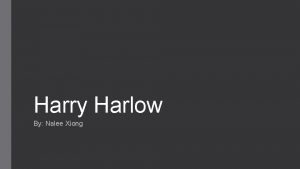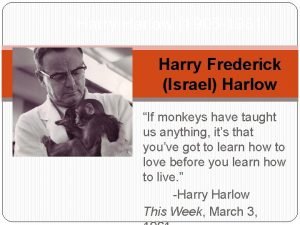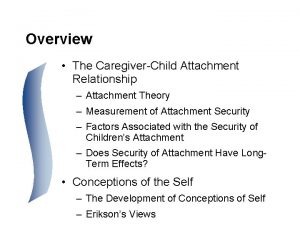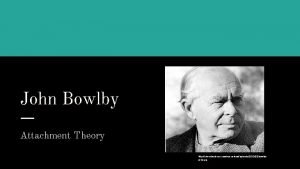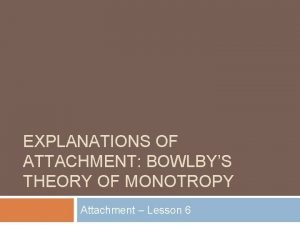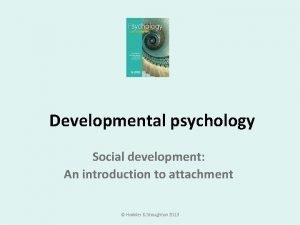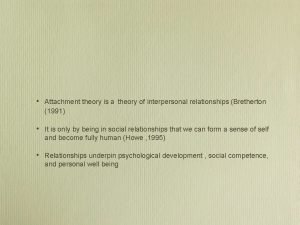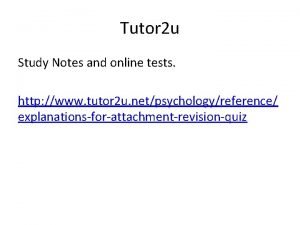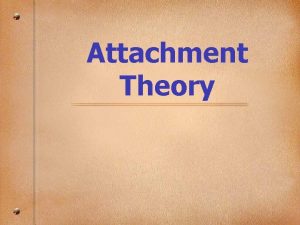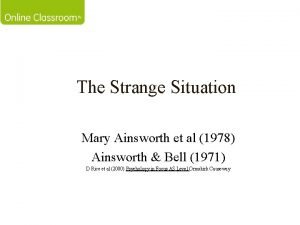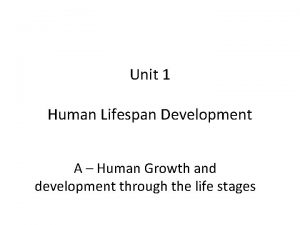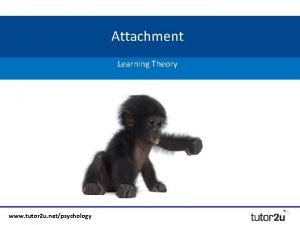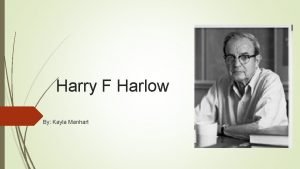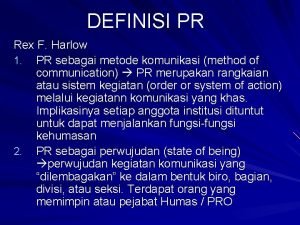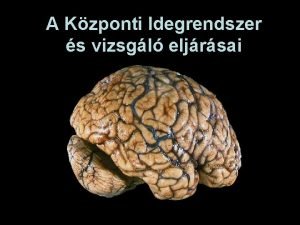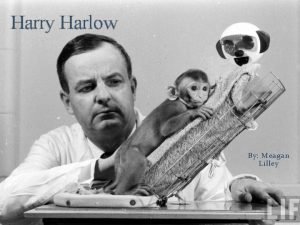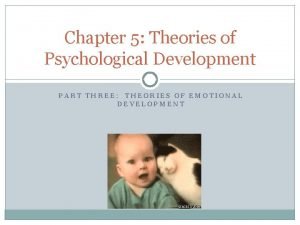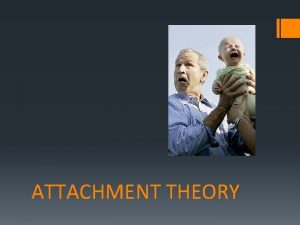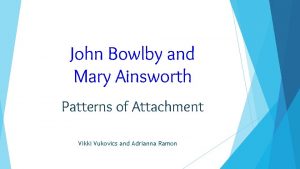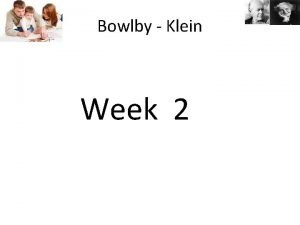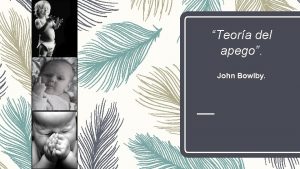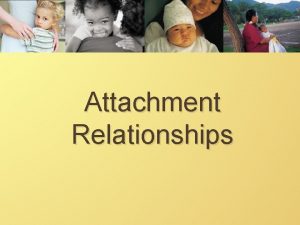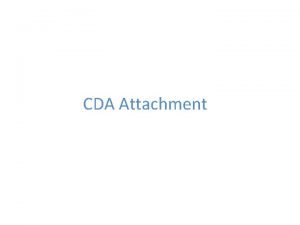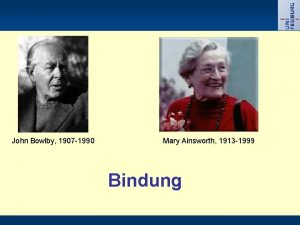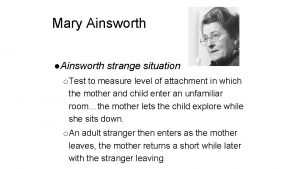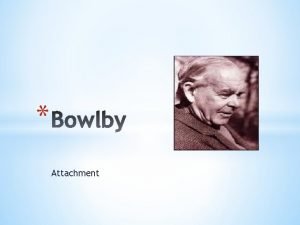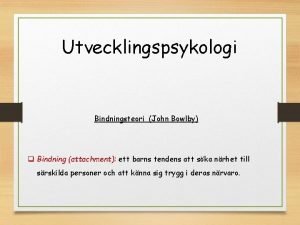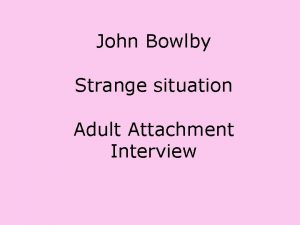Bowlby Harlow Ainsworth Attachment Theory Attachment Theory l

Bowlby, Harlow, Ainsworth Attachment Theory

Attachment Theory l There is a deep emotional tie, almost a l l physical connection with a loved one This is vital throughout life John Bowlby, Harry Harlow, Mary Ainsworth Powerful Survival Impulse Contact Comfort Monkeys Several Attachment Styles Existed

Theories of Attachment l Psychoanalytical Theory l l l Freudian Oral, Breast Feeding Behavioral/Learning Theory l l Infants become attached to people who feed and meet their needs The primary caregiver becomes the source of reinforcement – the infant will do whatever necessary to get the caregiver’s attention (cry, smile, babble)

Harlow’s Monkey Study How important is feeding? • Harlow researched this question in 1959 • Critical Question: Would the monkeys become attached to the wire “mother” who feeds them or the soft, cloth mother?

Monkey Study Experimental Design Results?

How does this apply to human babies? à Babies who are deprived of physical touch and emotional attachment were much more likely to suffer physical, social, emotional, and intellectual difficulties à Orphanages, Hospitals, Fathers, Daycares

Mary Ainsworth l Mary Ainsworth researched the ideas of attachment by placing human infants into novel situations. l Strange Situation: Ainsworth observed the reactions of babies when their parents left for a short time and then returned

Mary Ainsworth: Strange Situation l Infants with secure attachments (about 60 percent of the participants) confidently explore the novel environment while the parents are present l distressed when parent leaves l seek contact with parent upon returning. l

Mary Ainsworth: Strange Situation l The other Infants expressed insecure attachments Avoidant / Ambivalent attachment l Less likely to explore novel environment l Cries loudly when mother leaves or seems indifferent to departure or when she returns. l Harlow’s Monkeys were terrified when artificial mothers were removed from environment. l

Attachment and Relationships l Early attachments form the foundation of our adult relationships l Secure Attachments l Trust, confidence, self reliance l Insecure l Attachments Jealousy, promiscuity, relationship insecurity

Critical Period for Attachment l Imprinting: A process by which certain animals form attachments during a critical period early in life (Konrad Lorenz) l Optimal shortly after birth when an organism’s exposure to certain stimuli produces proper development l Attachment: Mere-exposure/familiarity

Parental Patterns l Daumrind’s three main parenting styles l Authoritarian parenting l Permissive parenting l Authoritative parenting

Parenting Style Quiz l Authoritarian l 2, 3, 7, 9, 12, 16, 18, 25, 26, 29 l Permissive l 1, 6, 10, 13, 14, 17, 19, 21, 24, 28 l Authoritative l 4, 5, 8, 11, 15, 20, 22, 23, 27, 30

Parenting Styles

Group Discussion l What makes your parents choose a particular parenting style? l What factors are involved? l Do parents use the same style with ALL of the children in the household? Explain.

Authoritarian Parenting l Style of parenting marked by imposing rules and expecting obedience l Low in warmth l Discipline is strict and sometimes physical. l Communication high from parent to child and low from child to parent l Maturity expectations are high.

Permissive Parenting l Style of parenting marked by submitting to children’s desired, making few demands, and using little punishment l High in warmth but rarely discipline l Communication is low from parent to child but high from child to parent. l Expectations of maturity are low.

Authoritative Parenting l Style of parenting marked by making demands on the child, being responsive, setting and enforcing rules, and discussing the reason behind the rules l High in warmth with moderate discipline l High in communication and negotiating l Maturity expectations are moderate.
- Slides: 18
